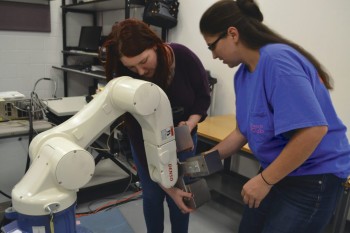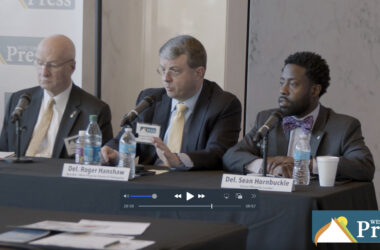
Lincoln University Ph.D. student Laura Nixon and research engineer Amy Tabb connect a container that holds stink bugs to a mechanical arm at the USDA Appalachian Fruit Research Station in Kearneysville. The machine swings the “bug box,” allowing Nixon to determine if motion causes the bugs to release their signature odor.
KEARNEYSVILLE, W.Va. – While the stink bug is ubiquitous in the Eastern Panhandle, the brown pest with its signature scent has not reached some foreign countries. That’s why two Ph.D. students from New Zealand are currently studying stink bug behavior at the USDA Appalachian Fruit Research Station in Kearneysville: to keep the bugs from reaching the shores of their country.
Laura Nixon, a visiting Ph.D. student from Lincoln University in New Zealand, and Carol Bedoya, a Ph.D. student from the University of Canterbury in New Zealand, are the two researchers working to understand the behavior of the brown marmorated stink bug–and how to squash the species’ destruction of agricultural crops.
“The main focus for this lab has really been to research bugs during the growing season, during the summer and in the spring,” said Dr. Rob Morrison, postdoctoral researcher at the Appalachian Fruit Research Station. “Now, we have a little more opportunity to start asking questions about their behavior in going into overwintering structures, which is a big nuisance for homeowners. It’s important to understand (the stink bugs’) behavior.”
“New Zealand doesn’t have stink bugs yet, so our goal is to keep them out,” he continued.
Nixon said she is studying chemicals released by stink bugs as they prepare to overwinter, when they invade homes and hibernate in boxes, clothing drawers and other cozy places for the winter.
“(I want to know) whether they release their smelly chemicals as a defensive mechanism when they’re overwintering and whether they’re releasing anything else,” Nixon said. “The idea is really to see if they can be detected by the chemicals they release.”
Part of Nixon’s research involves studying the effects of movement and temperature change on stink bug behavior, with the more specific focus on what makes the bugs wake up and spray their stink.
One way Nixon can study the effects of motion on stink bugs is with a robotic arm that swings a metal container full of drowsy stink bugs in a rocking motion, to simulate the movement of cargo on a ship. By watching the bugs crawl out of the box, she can tell how the motion is affecting the bugs– and she can usually smell the results.
“One of the things I found is that they release the stink while they’re asleep, and they’re actually more likely to release it then because they’re more easily disturbed and more likely to release defensive chemicals. I’m still collecting data on the movement,” she said.
Bedoya is studying bioaggression and communication in stink bugs, specifically, the sound frequencies emitted by his smelly subjects. His research may explain why stink bugs are usually seen congregating in large groups.
“Almost nobody knows they produce vibrations to communicate with each other,” he said. “I’m studying those vibrations in a specific behavior and that is when they are aggregating. I want to know if those vibrations play a relevant role in the aggregation behavior.”
In his research, Bedoya places stink bugs in mesh boxes housed in a soundproof chamber. Using electronic audio recording equipment, he is able to listen in on the stink bugs’ communication.
Bedoya can then play the recordings back on a computer, with colorful bars visualizing the vibration frequencies, which sound like the loud, low rumbling of an engine when amplified through speakers.
Morrison said New Zealand is a big exporter of fruits and vegetables, so part of Nixon and Bedoya’s research is centered around how to keep the brown bugs from destroying crops there, and keeping them from multiplying the way they have in the U.S.
“New Zealand is very concerned about the brown marmorated stink bug and other species because they have a high-value fruit and vegetable industry. They export a lot of their stuff so they want to keep their borders safe. It was likely the stink bug was introduced to the U.S. via shipping containers,” he said. “For a long period, maybe five or six years, we didn’t even know it was in the country. Upon closer inspection, we realized it was actually in the United States and had all that time to reproduce and multiply. We experienced our first outbreak year in about 2008 or 2009 in the Mid-Atlantic region.”
Morrison said he wished researchers in the U.S. had the foresight to stop the accidental importing of stink bugs “before we knew how dangerous this species is.”
While a big stink is being made about Nixon and Bedoya’s high-tech lab research, the students are also looking at real-world applications for their research.
Nixon said she hopes her chemical studies will allow easy detection of stink bugs at airports and sea ports to avoid them making their way into New Zealand.
Bedoya said his research could potentially result in the creation of stink bug repellents or traps.
“The implication could be an acoustic trap. You could use the vibrations to attract them. If you can elicit that signal whenever you want and you can detect that signal, it could be used as a method for detection,” Bedoya said. “Another application would be related to biosecurity uses to detect them in airports and ports of entry.”
Bedoya and Nixon will be in the U.S., studying at the USDA Appalachian Fruit Research Station, for about two months before returning to their home country.
“We came here to study because this is where the stink bugs are. I don’t want to bring any back with me,” Nixon said, tongue-in-cheek. “I better check my luggage very carefully.”
Staff writer Mary Stortstrom can be reached at 304-263-8931, ext. 138, or www.twitter.com/mstortstromJN.





